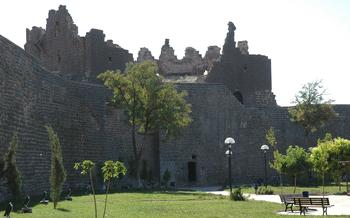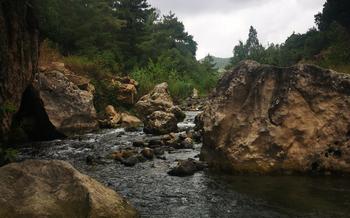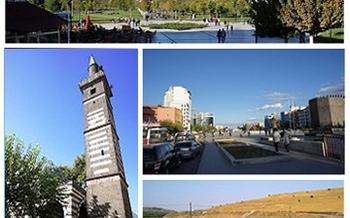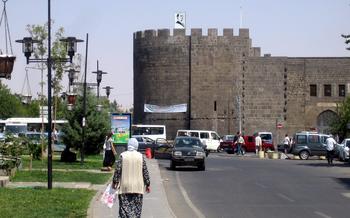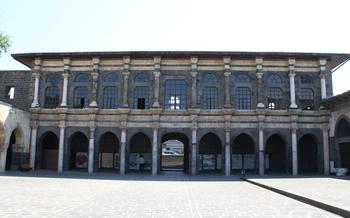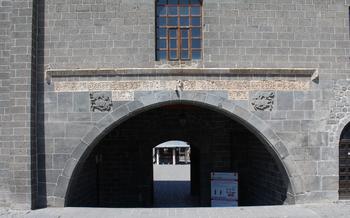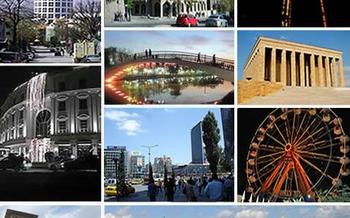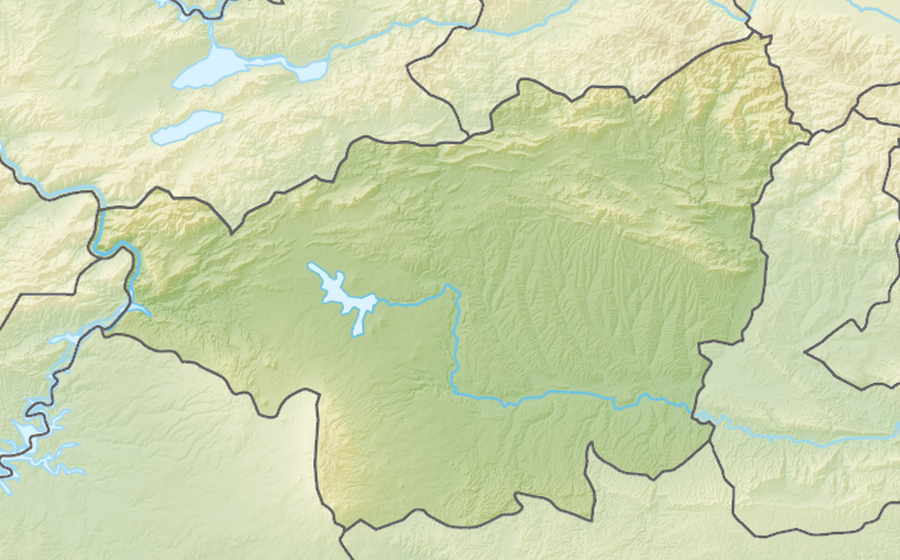
Eğil District Historical Sites
- Eğil District: A Historical Gem in Diyarbakır
- Explore the Ancient City of Mardinkapı
- Discover the Ruins of the Eğil Castle
- Admire the Ulu Mosque's Architectural Beauty
- Step into the Eğil Bazaar for Local Delights
- Witness the Grandeur of the Zinciriye Madrasah
- Visit the Sacred Tomb of Nebi Yunus
- Take a Scenic Walk along the Tigris River
- Indulge in Local Cuisine at Traditional Restaurants
- Shop for Unique Souvenirs in Local Markets
- Attend Local Festivals and Events
- Experience the Warmth of Local Hospitality
- Explore the Surrounding Villages for Hidden Gems
- Admire the Natural Beauty of the Eğil Region
- Insider Tip: Unveiling a Hidden Gem for History Buffs
Eğil District: A Historical Gem in Diyarbakır
In the heart of Diyarbakır, Turkey, lies the enchanting Eğil district, a treasure trove of historical wonders and cultural significance. Steeped in a rich past that dates back to ancient times, Eğil has preserved its unique identity through numerous civilizations, each leaving behind their mark on this captivating land.
Conveniently located just 50 kilometers from the city center, Eğil is easily accessible by road or public transportation. The best time to visit this historical gem is during the spring or autumn when the weather is pleasant and ideal for exploring its many attractions.
As a cultural and religious hub, Eğil holds immense importance for locals and tourists alike. The district is home to several ancient sites, mosques, and madrasahs, reflecting the diverse heritage and religious influences that have shaped its history.
Explore the Ancient City of Mardinkapı
Mardinkapı, once a bustling ancient city, now lies in ruins, yet its remnants whisper tales of past grandeur. Excavations have revealed the foundations of houses, shops, and public buildings, offering a glimpse into the city's urban layout. Among the ruins, the most prominent are the remains of a large church, believed to date back to the 4th century AD. Its intricate carvings and well-preserved mosaics provide a testament to the city's artistic prowess.
Mardinkapı's strategic location on the banks of the Tigris River made it a vital trade hub in ancient times. Its inhabitants engaged in commerce with far-off lands, bringing prosperity to the city. The discovery of imported goods, such as pottery and glassware, attests to the city's extensive trading network.
Historical accounts mention Mardinkapı as a significant center of Christianity in the region. The presence of numerous churches and monasteries suggests that the city played a crucial role in spreading the Christian faith. The ruins of these religious structures, with their distinctive architectural features, offer insights into the religious practices and beliefs of the city's inhabitants.
Entry to the ancient city of Mardinkapı is free, and visitors are welcome to explore the ruins at their leisure. However, it's advisable to visit during daylight hours, as the site lacks proper lighting. The best time to visit is in the spring or autumn when the weather is pleasant for outdoor exploration.
Discover the Ruins of the Eğil Castle
The Eğil Castle, an imposing historical landmark, stands as a symbol of the region's rich past. Built in the 12th century, the castle once served as a formidable defensive structure, protecting the city from invaders. Constructed with local black basalt, the castle's impressive fortifications have withstood the test of time, showcasing the exceptional craftsmanship of its builders.
Ascending to the castle's summit, visitors are rewarded with breathtaking panoramic views of the surrounding landscape. From this vantage point, the Tigris River meanders through the fertile plains, creating a picturesque vista that stretches as far as the eye can see. The castle's strategic location allowed its inhabitants to keep a watchful eye over the surrounding countryside, ensuring the safety of the Eğil region.
Exploring the castle's interior reveals a labyrinth of chambers, passageways, and towers, each hinting at the castle's former glory. Visitors can wander through the remnants of the great hall, where important decisions were made, and picture the bustling activity that once filled these spaces. The castle's architecture showcases a blend of Byzantine and Islamic influences, reflecting the diverse cultural heritage of the region.
Admire the Ulu Mosque's Architectural Beauty
The Ulu Mosque, also known as the Great Mosque of Eğil, stands as a testament to the region's rich history and architectural prowess. Built in the 12th century during the Artuqid dynasty, this magnificent structure has undergone several renovations and additions over the centuries, blending architectural influences from various periods.
The mosque's exterior is adorned with intricate carvings and decorative elements, showcasing the skill and artistry of its builders. Its towering minaret, a prominent landmark in the city, offers breathtaking panoramic views of the surrounding landscape. Inside, visitors are greeted by a spacious prayer hall supported by rows of elegant columns and arches. The intricate tilework, calligraphy inscriptions, and stained-glass windows create a mesmerizing ambiance, evoking a sense of awe and spirituality.
As one of the oldest and most significant mosques in the region, the Ulu Mosque holds immense religious and cultural importance. It has served as a center for worship, education, and community gatherings for centuries, contributing to the vibrant cultural heritage of Eğil.
Entry Fees and Visiting Hours:
- The Ulu Mosque is open to visitors daily during prayer times and outside of prayer times.
- Entry is free of charge, allowing visitors to freely explore the mosque's stunning architecture and serene atmosphere.
- It is important to dress respectfully when visiting the mosque, covering shoulders and knees.
- Visitors are kindly requested to be mindful of the ongoing religious activities and maintain silence while inside the prayer hall.
Step into the Eğil Bazaar for Local Delights
Immerse yourself in the vibrant atmosphere of the Eğil Bazaar, where the air is filled with the enticing aromas of local delicacies and the buzz of haggling shoppers. This bustling marketplace is a haven for those seeking unique souvenirs and handmade crafts that reflect the rich cultural heritage of the region.
From intricate rugs adorned with traditional motifs to colorful pottery showcasing vibrant patterns, the bazaar offers a treasure trove of locally produced items. Discover the art of skilled artisans who pour their passion and creativity into each piece, creating unique works that tell stories of the land and its people.
As you stroll through the labyrinthine alleys of the bazaar, don't miss the opportunity to sample the mouthwatering local cuisine. Indulge in freshly baked pastries, sweet treats, and savory snacks that will tantalize your taste buds and leave you craving more.
Remember to embrace the local custom of haggling when making purchases. It's a friendly and interactive way to connect with the vendors and score the best deals. Don't be afraid to engage in good-natured bargaining, as it's all part of the shopping experience.
For the ultimate bazaar experience, visit on a weekday morning to avoid the weekend crowds and take advantage of the best prices. Immerse yourself in the lively ambiance, interact with the friendly locals, and discover hidden gems that will serve as cherished reminders of your time in Eğil.
Witness the Grandeur of the Zinciriye Madrasah
In the heart of Eğil, stand in awe of the Zinciriye Madrasah, a testament to the region's rich architectural heritage. Built in the 12th century, this madrasah, or Islamic school, is a masterpiece of Seljuk architecture. Admire its intricate stone carvings, geometric patterns, and graceful arched doorways. The madrasah's courtyard, with its central fountain and surrounding arcade, offers a tranquil space for contemplation and learning. Explore the madrasah's well-preserved cells, where students once resided and studied. The Zinciriye Madrasah is a living testament to the Eğil district's dedication to education and Islamic scholarship. Embrace the opportunity to delve into its history and immerse yourself in the atmosphere of this architectural gem.
Entry Fees and Visiting Hours: The Zinciriye Madrasah is open to the public with a nominal entrance fee. Visiting hours are typically from 9 am to 5 pm, but it's advisable to check with local authorities for any changes or special arrangements.
Visit the Sacred Tomb of Nebi Yunus
The tomb of Nebi Yunus, also known as the Prophet Jonah, is a revered site for both Muslims and Christians. According to religious texts, the prophet was swallowed by a whale and remained in its belly for three days before being cast ashore near Nineveh. The tomb, believed to be the final resting place of Nebi Yunus, attracts pilgrims and visitors from around the world.
The tomb complex consists of a mosque, a türbe (mausoleum), and a courtyard. The türbe, where the prophet is said to be buried, is a simple yet elegant structure with a domed roof. Inside, visitors can pay their respects and offer prayers. The mosque, located adjacent to the türbe, is a popular place of worship for both locals and pilgrims.
Beyond its religious significance, the tomb of Nebi Yunus also offers a glimpse into the rich history and culture of the region. The surrounding area is dotted with ancient ruins and historical sites, including the remains of a once-thriving city. Visitors can explore these sites and learn about the region's past, making a visit to the tomb of Nebi Yunus a truly immersive and meaningful experience.
Entry fees and visiting hours:
Entry to the tomb of Nebi Yunus is free of charge. The complex is open to visitors throughout the day, but it is advisable to visit during daylight hours for safety reasons.
Take a Scenic Walk along the Tigris River
The Tigris River, one of the world's oldest and most significant rivers, flows through the heart of the Eğil district, creating a picturesque and tranquil setting. Embark on a leisurely walk along its banks and immerse yourself in the region's natural beauty and historical significance.
Stroll along the paved walkways, enjoying the cool breeze and the soothing sound of the river's gentle currents. Marvel at the ancient ruins that dot the riverbanks, remnants of civilizations past. Spot wildlife such as birds, turtles, and even the occasional otter frolicking in the water.
Take a moment to sit on one of the many benches and soak in the serene atmosphere. Contemplate the river's long journey from its source in the mountains of Turkey to its meeting with the Euphrates in Iraq. Reflect on the countless civilizations that have thrived along its banks, leaving behind a rich legacy of culture and history.
For those seeking a more active experience, the Tigris River offers opportunities for kayaking, canoeing, and fishing. Embark on a guided boat tour to explore hidden coves and discover the river's diverse ecosystem.
Whether you choose to stroll, sit, or paddle, a walk along the Tigris River promises a rejuvenating and enriching experience, connecting you with nature, history, and the timeless beauty of the Eğil district.
Indulge in Local Cuisine at Traditional Restaurants
To truly immerse yourself in the culture of Eğil, a culinary adventure is a must. The region boasts a rich and diverse cuisine influenced by its unique history and geography. Don't miss the chance to savor the tantalizing flavors of traditional dishes that have been passed down through generations.
Must-Try Regional Dishes and Delicacies
-
Mırra: A hearty soup made with lamb, vegetables, and spices, often served with freshly baked bread.
-
Çiğ Köfte: A spicy raw meatball dish made with bulgur, spices, and herbs, served with fresh vegetables.
-
Kebap: Succulent grilled meats, such as lamb kebabs and Adana kebabs, seasoned with aromatic spices.
-
Lahmacun: A thin and crispy flatbread topped with minced lamb, vegetables, and herbs, similar to a Turkish pizza.
-
Baklava: Layers of filo pastry filled with chopped nuts, sweetened with honey or syrup, a must-try pastry.
Recommended Restaurants for Authentic Experiences
-
Mardinli Ahmet Usta: Known for its exceptional kebabs and traditional Turkish cuisine.
-
Diyarbakır Sofrası: Offers a wide range of regional dishes, including Mırra and Çiğ Köfte.
-
Kebapçı Halil Usta: A local favorite for grilled meats and kebabs.
-
Baklava Evi: A renowned patisserie specializing in freshly made baklava and other Turkish sweets.
Cultural Insights and Dining Etiquette
-
Dining in Eğil is a social experience, often shared with family and friends.
-
It's customary to remove your shoes before entering a traditional restaurant.
-
Don't be afraid to ask for recommendations and try new dishes.
-
Tipping is not mandatory but always appreciated.
Vegetarian and Vegan Options
-
While meat dishes dominate the menu, there are vegetarian and vegan options available.
-
Look for dishes like stuffed grape leaves, lentil soup, and vegetable kebabs.
-
Many restaurants can accommodate special dietary requests with advance notice.
Shop for Unique Souvenirs in Local Markets
Eğil's vibrant local markets are a treasure trove of unique souvenirs and handmade items crafted by skilled local artisans. From intricate carpets and colorful textiles to hand-painted pottery and gleaming copperware, there's something to suit every taste and budget. Dive into the labyrinthine alleys and discover hidden gems tucked away among the stalls.
Haggling is not just a tradition but an art form in local markets. Embrace the friendly banter and negotiate prices with a smile. You'll not only score great deals but also gain insights into the local culture.
For the best bargains, aim to visit the markets early in the morning or towards the end of the day when vendors are more willing to offer discounts. Remember, supporting local markets means supporting the livelihoods of the talented artisans who create these beautiful items.
Practical tip: Carry small bills for easier transactions and avoid using credit cards, as many vendors prefer cash.
Attend Local Festivals and Events
Diyarbakır, and particularly the Eğil district, is renowned for its vibrant cultural heritage and lively festivals. These events offer a unique opportunity to immerse yourself in the local traditions, witness captivating performances, and savor delicious regional cuisine.
One of the most prominent festivals is the Eğil Kültür ve Sanat Festivali (Eğil Culture and Art Festival), held annually in May. This colorful extravaganza showcases the district's rich cultural tapestry through traditional music, dance, and theater performances. Local artisans and craftsmen also display and sell their handmade products, from intricate jewelry to vibrant textiles.
For those interested in religious and spiritual traditions, the Nebi Yunus Anma Törenleri (Prophet Jonah Commemoration Ceremonies) is a must-attend event. Held in September, this festival celebrates the life and legacy of the prophet Jonah, who is believed to be buried in Eğil. Pilgrims from across the region gather for prayers, religious ceremonies, and communal feasts.
To experience the culinary delights of the region, don't miss the Eğil Yemek Festivali (Eğil Food Festival). Held in October, this gastronomic extravaganza features a mouthwatering array of traditional dishes, from hearty stews to delectable pastries. Visitors can indulge in local delicacies, learn about regional cooking techniques, and interact with local chefs.
Whether you're a history buff, a culture enthusiast, or a foodie, Eğil's festivals offer an unforgettable experience, allowing you to delve into the heart of this historic district and create lasting memories. To make the most of your festival experience, remember to dress respectfully, embrace the local customs, and be prepared for large crowds.
Experience the Warmth of Local Hospitality
The people of the Eğil district are renowned for their warm hospitality and welcoming nature. They take pride in their rich cultural heritage and are eager to share it with visitors. As you explore the region, you'll encounter friendly locals who are always willing to lend a helping hand or offer a smile.
To fully immerse yourself in the local culture, it's important to be respectful of their customs and traditions. Dress modestly, avoid public displays of affection, and always ask permission before taking photos of people or religious sites.
Although English proficiency may be limited in some areas, don't let language barriers deter you from interacting with the locals. A friendly smile and a few basic Turkish phrases can go a long way in bridging the communication gap.
Take the time to engage with the locals, ask questions about their lives, and share stories of your own. Building connections with the people of Eğil will not only enhance your travel experience but also create lasting memories that you'll cherish long after your trip.
Explore the Surrounding Villages for Hidden Gems
Beyond the historical treasures of Eğil district, the surrounding villages offer a glimpse into the region's rich cultural heritage and natural beauty. Venture off the beaten path to discover hidden gems and experience the authentic charm of rural Turkey.
Transportation options are readily available, with local buses and taxis connecting Eğil to the neighboring villages. For a more immersive experience, consider hiring a local guide who can provide insights into the local culture and history.
As you explore the villages, you'll encounter warm and welcoming locals who are eager to share their traditions and customs. Engage in conversations, learn about their way of life, and savor the opportunity to connect with the community.
Whether you're interested in delving into the history of ancient civilizations or simply seeking tranquility amidst picturesque landscapes, the surrounding villages offer a wealth of experiences for the curious traveler.
Admire the Natural Beauty of the Eğil Region
Beyond its rich history and cultural heritage, Eğil also boasts stunning natural beauty that beckons outdoor enthusiasts and nature lovers. The region is home to picturesque landscapes, rolling hills, and lush greenery, offering a refreshing contrast to the bustling city streets.
For those seeking adventure, there are several hiking trails that wind through the scenic countryside, providing opportunities to explore the region's diverse flora and fauna. Keep an eye out for colorful wildflowers, majestic birds, and perhaps even a glimpse of the local wildlife.
Don't miss the chance to visit the nearby Eğil Dam, a remarkable feat of engineering that has created a tranquil lake surrounded by breathtaking views. Take a leisurely stroll along the dam's edge, admiring the serene waters and the picturesque backdrop of the surrounding mountains.
If you're visiting during the warmer months, pack a picnic lunch and find a spot by the river to soak up the sun and enjoy a relaxing afternoon surrounded by nature's beauty. The Eğil region offers a harmonious blend of history, culture, and natural wonders, ensuring a truly unforgettable experience for every traveler.
To make the most of your outdoor exploration, consider visiting during the spring or fall when the weather is at its most pleasant. Remember to pack comfortable shoes, sunscreen, and a hat to protect yourself from the sun. Local guides are available for hire if you're interested in learning more about the region's natural history and hidden gems.
Insider Tip: Unveiling a Hidden Gem for History Buffs
Beyond the well-known attractions, Eğil holds a hidden gem for history enthusiasts—the ruins of the ancient city of Amida. Once a thriving metropolis, Amida dates back to the 4th century BC and served as the capital of the Kingdom of Sophene. As you explore the ruins, you'll discover remnants of the city's glorious past, including fortifications, temples, and public buildings.
To reach Amida, you can take a short drive from Eğil town. The site is easily accessible and offers a unique opportunity to immerse yourself in the region's rich history. As you wander among the ruins, imagine the city's bustling streets, the grandeur of its palaces, and the echoes of ancient civilizations.
For the best experience, visit Amida early in the morning or late afternoon to avoid the midday heat. Be sure to bring comfortable shoes, as the terrain can be uneven, and a camera to capture the stunning views. Combining your visit to Amida with other nearby attractions, such as the Ulu Mosque or the Zinciriye Madrasah, will provide a comprehensive historical journey through Eğil.
